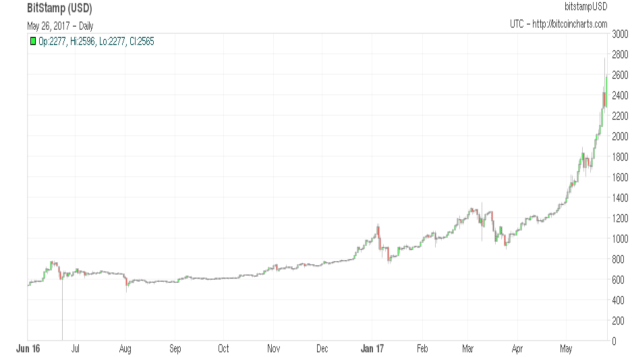
A quick pre-bank holiday rundown of our “charts that matter” this week. And I think we should start with the jaw dropper – our old friend, bitcoin.
It’s fair to say that this one’s going parabolic.
(Source: bitcoincharts.com)
And it’s not the only cryptocurrency that’s had a great year so far. Far from it.
The total dollar value (or market capitalisation, if you like) of all cryptocurrencies in issue has gone from less than $25bn at the start of this year to more than $75bn now.
Charts that look like the one above rarely end well (the Nasdaq circa the late 1990s is one example. Japan in the late 1980s is another). But they also often herald the arrival of a new era and one of significant change.
Cryptocurrencies – for all the scandal and all the hype – aren’t going to go away. Ben Thompson at Stratechery has a good post up in which he draws the same conclusion as I have. This might be a bubble, but if so, it’s like the tech bubble – the market might be getting ahead of itself, but it’s the birthing pains of a useful new technology that we’re now seeing.
By the way, if you’re interested in actually investing in bitcoin and cryptocurrencies, I’d advise you to tread carefully. But you might also be interested in this presentation from one of my colleagues, Sam Volkering. Sam’s a big tech evangelist and he’s been following bitcoin since the very earliest days. You can find out more here.
By comparison, everything else was a little tame this week. After a strong comeback the previous week, gold was mostly flat. On the one hand, with stock markets hitting new highs and “sexy” things like cryptocurrencies rocketing, fewer people want to keep their money in boring, old gold.
On the other hand, there are still a lot of political jitters, and the US dollar has been relatively weak, so that’s kept gold nicely propped up.
As the dollar has weakened and the wider market has become a little more bullish, the price of copper has picked up somewhat. But markets are still wary on the reflation trade. It’s worth keeping an eye on China to see what happens here (and the pummelling the oil price took yesterday won’t help either).
The US dollar had another faltering week. There were no surprises from the Federal Reserve to prop up the US currency when minutes from its latest meeting came out, and the euro has been making hay. We’re probably due a pause in the action – and it looks like we’ve had the beginnings of one – but I reckon the weak dollar trend remains intact.
Meanwhile, yields on ten-year US Treasury bonds were little changed on the week – they ended last week on 2.23%, and edged higher to 2.25%. The Fed, again, is partly responsible. The minutes from the US central bank’s latest meeting suggested that there is still no huge rush to raise rates. Markets still don’t see them as “behind the curve”, but they’re certainly not in a hurry to get ahead of it either.
That brings us to the latest US jobless claims data. David Rosenberg of Gluskin Sheff sees this is a valuable leading indicator. When the figure hits a “cyclical trough” (as measured by the four-week moving average), a stock market peak is not far behind, and a recession follows about a year later.
The thing is, up until recently, it looked as though jobless claims had troughed at just under 240,000 at the end of February. So we’d be looking at the market (the S&P 500) peaking around the end of May – at least if you take an average of what’s happened in the past.
But we’ve just hit a fresh low. Claims came in at 238,000 for the week ending 20 May. The four-week average is now at 235,250, its lowest level since April 1973. So if nothing else, if history repeats itself, we’ve pushed the stock market peak back until the end of August.
Obviously, this is a very loose measure, based on a small historical sample (and therefore not statistically significant), so it’s not something to base your investing on alone. In other words, don’t bet all your money on the S&P 500 continuing higher just because this particular indicator suggests that it will.
What interests me more is to see US employment coming in this strong at a time when wage inflation is still pretty weak. Something’s got to give, surely.